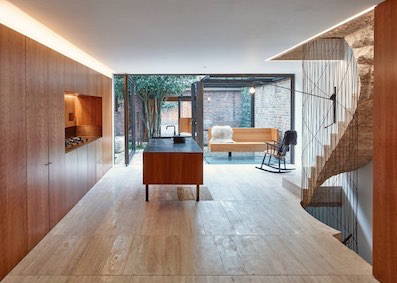KBzine: the original kitchen and bathroom industry e-news - since 2002
28th January 2021
We strongly recommend viewing KBzine full size in your web browser. Click our masthead above to visit our website version.
American cherry brings sophistication to London home
A min Taha Architects + Groupwork have renovated a 1950s house in London's Bayswater area, cleverly restoring Travertine and cherry panelling using American cherry - a premium wood with a creamy white sapwood and rich reddish brown heartwood, with a fine uniform straight grain and smooth texture.
min Taha Architects + Groupwork have renovated a 1950s house in London's Bayswater area, cleverly restoring Travertine and cherry panelling using American cherry - a premium wood with a creamy white sapwood and rich reddish brown heartwood, with a fine uniform straight grain and smooth texture.
Popular for its subtle grain patterns and warm colours, the wood is of medium density with good bending properties and medium strength and shock resistance. It will darken as it ages.
American cherry is used for many high-end applications including architectural joinery, furniture, cabinets, flooring and musical instruments. Although cherry accounts for less than 2% of the growing hardwood resource, it is widely available in a full range of specifications and grades as both lumber and veneer.
The house is in Caroline Place, a quiet enclave of late 1950s terraces north of Hyde Park and Kensington Gardens. Built with a modern Northern European sensibility of sharp brick lines and crisp mortar joints layered with softer timber detailing, the interior layouts remained firmly rooted in an earlier English Edwardian tradition.
"We were thrilled to be using cherry in this project as it is a much under-used wood," says Amin Taha. "It's the perfect material for interior projects because it's smooth, warm and very easy to finish as a luxurious surface."
The house had a separation of served and servant areas of maids' rooms, sculleries, coalhouses with a working rear yard. Servants occupied the ground level with owners set out above, across larger, light-filled rooms. In the immediate post-war period Bayswater had begun to lose its lustre to that class, so much so that within a decade of being built, its new, younger inhabitants found these social conventions to be out of step with their aspirations. The house was remodelled and cleared of the interior sub-dividing walls and, where possible, the exterior, replacing these with what was felt appropriate at the time.
Four decades on, the new occupiers, a family of five, retain the aspiration for open-plan living with a desire for tactile material finishes and inevitably to different tastes.
A load bearing cantilevered Travertine staircase rises from the basement floor with its underside left as 'quarry found', while spiralling and rising to the skylight above. Together, these strategies helped structure and define the new occupants' preferred way of living, leaving enough flexibility for them to grow, change and delight in its details, which is perhaps the longer legacy of the restoration.
Early works revealed remains of original travertine flooring, densely plastered walls behind the 1970's pine boarding and one room lined with dark American cherry timber panelling.
The architects use cherry timber panelled cabinetry to spatially define the areas between rooms.
The first floor can be occupied wholly as a single reception room with a corner study area. Two adjacent full height bookcases can fold out and slide doors to firstly enclose the room then sub-divided it from the study. One of the bookcases, when pivoted, can fold out a guest bed to change the study to a bedroom.
Cabinetry elements are for these purposes all full height with shadow gaps and rebated lighting details to emphasise them as standalone and detached servants. Their purpose and scale are further expanded to provide utility in the form of bathrooms, walk-in wardrobes, and laundry rooms. As they are present with access and knowledge to all areas of the house their discretion is kept within rooms and passages behind secret doors and bookcases.
"American cherry is one of the world's finest and fastest growing temperate hardwoods, yet it is still being underutilised," remarks David Venables, european director at the American Hardwood Export Council.
"Caroline Place is a superb example of how this sustainable species with its rich reddish brown colour can add a layer of warmth and sophistication to a project."
AHEC is the leading international trade association for the US hardwood industry, representing the committed exporters among American hardwood companies and all the major US hardwood product trade associations.
5th January 2018








